
Halle (Saale), or simply Halle (German:[ˈhalə]; from the 15th to the 17th century: Hall in Sachsen; until the beginning of the 20th century: Halle an der Saale ; from 1965 to 1995: Halle/Saale) is the largest city of the German state of Saxony-Anhalt. It is the fifth-most populous city in the area of former East Germany after (East) Berlin, Leipzig, Dresden and Chemnitz, as well as the 31st-largest city of Germany. With around 244,000 inhabitants, it is slightly more populous than the state capital, Magdeburg. With Leipzig, the largest city of Saxony, Halle forms the polycentric Leipzig-Halle conurbation. Leipzig/Halle International Airport lies between the two cities, in Schkeuditz. The Leipzig-Halle conurbation is at the heart of the larger Central German Metropolitan Region.
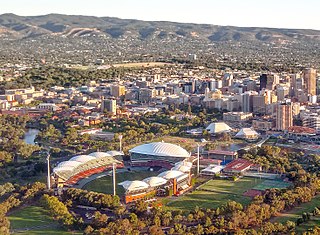
The Adelaide Oval is a sports ground in Adelaide in the state of South Australia. It is located in the parklands between the city centre and North Adelaide. The venue is predominantly used for cricket and Australian rules football, but has also played host to rugby league, rugby union, soccer, and tennis, as well as regularly being used to hold concerts.

The Olympiastadion, also known in English as the Berlin Olympic Stadium or simply the Olympic Stadium, is a sports stadium at Olympiapark Berlin in Berlin, Germany. It was originally designed by Werner March for the 1936 Summer Olympics. During the Olympics, the record attendance was thought to be over 100,000.

The Drum Tower of Beijing, or Gulou, is situated at the northern end of the central axis of the Inner City to the north of Di'anmen Street. Originally built for musical reasons, it was later used to announce the time and is now a tourist attraction.

Cassano d'Adda is a town and comune in the Metropolitan City of Milan, Lombardy, Italy, located on the right side of the Adda River. It is on the border of the Metropolitan City of Milan and the province of Bergamo. It is served by Cassano d'Adda railway station.
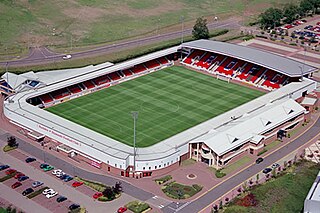
Nene Park was a sports stadium situated at Irthlingborough, Northamptonshire, England, along the bank of the River Nene, which could accommodate 6,441 spectators, with 4,641 seated and 1,800 standing. It formerly hosted football matches but at its time of demolition it was unused. The car park could hold 800 vehicles. From 1992 until the club's demise in 2011, it was the home ground of Rushden & Diamonds, having from 1969 been the home of predecessor Irthlingborough Diamonds. It became Kettering Town's home for 18 months, but the club left the venue in November 2012 to play at Corby, due to the costs of running the ground. Demolition of the ground began in late February 2017 and lasted approximately two and a half months.

The Stadio Olimpico Grande Torino, named after the Grande Torino team, is a multi-purpose stadium located in Turin, Italy. It is the home ground of Serie A club Torino Football Club. The stadium is located in Piazzale Grande Torino, in the district of Santa Rita, in the south-central area of the city. The stadium is currently rated by UEFA as a Category 4 stadium, the highest ranking possible.
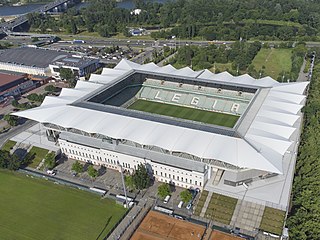
The Polish Army Stadium, official named the Marshall Józef Piłsudski Legia Warsaw Stadium, is an all-seater, highest fourth category football-specific stadium located at 3 Łazienkowska Street in the Śródmieście district, Powiśle area, within the square of the streets: Łazienkowska, Czerniakowska, Kusocińskiego and Myśliwieck. It is the home ground of Legia Warsaw football club, who have been playing there since 9 August 1930.

The Velodrom (velodrome) is an indoor track cycling arena, in the Prenzlauer Berg locality of Berlin, Germany. Holding up to 12,000 people, it was also Berlin's largest concert venue, until the opening of O2 World in 2008.

Stadion der Weltjugend was a multi-use stadium in the locality of Mitte in the eponymous borough of Mitte in Berlin, Germany. It was inaugurated on 20 May 1950 by the First Secretary of the Socialist Unity Party, Walter Ulbricht for the first "Deutschlandtreffen of the Free German Youth. The stadium was named after Walter Ulbricht. In the vernacular of Berlin, the stadium was later called Zickenwiese after Ulbricht's beard.

Sportforum Hohenschönhausen, officially named Sportforum Berlin, is a multi-purpose sports complex in the locality of Alt-Hohenschönhausen of the borough of Lichtenberg in Berlin. The Sportforum was also known as the Dynamo-Sportforum during the East German era.
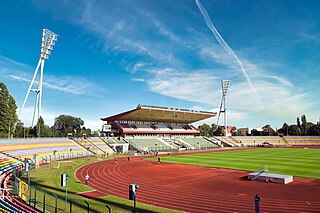
The Friedrich-Ludwig-Jahn-Sportpark is a multi-purpose sports complex located in the western part of the locality of Prenzlauer Berg in the borough of Pankow in Berlin. The sports complex covers an area of approximately 22 hectares and comprises several facilities. The main building is the Friedrich-Ludwig-Jahn-Stadion. The stadium is the third-largest stadium in Berlin, after the Olympiastadion and the Stadion An der Alten Försterei, with a capacity of approximately 20,000 seats, of which 15,000 are covered. The most recent main tenants of the stadium have been VSG Altglienicke and Berlin Thunder. Friedrich-Ludwig-Jahn-Sportpark was the venue for the 2018 World Para Athletics European Championships. The large stadium is planned for a complete redevelopment. Demolition of the stadium began on 8 October 2024.
The 1956 VFL season was the 60th season of the Victorian Football League (VFL), the highest level senior Australian rules football competition in Victoria. The season featured twelve clubs, ran from 14 April until 15 September, and comprised an 18-game home-and-away season followed by a finals series featuring the top four clubs.

The Poststadion is a multi-use stadium in the locality of Moabit of the borough of Mitte in Berlin, Germany. The stadium was built in 1929 for the sports club of the German Reichspost at the site of a former Prussian Uhlan parade ground. It is adjacent to the Fritz Schloß Park.

Volkspark Friedrichshain is a large urban park on the border of the Berlin neighborhoods of Friedrichshain and Prenzlauer Berg. The oldest public park in Berlin, at 52 hectares, it is also the fourth-largest, after Tempelhofer Park, Tiergarten, and Jungfernheide.

The 1952 Winter Olympics were held in and around Oslo, Norway, from 14 to 25 February 1952. Ten competition and eight non-competition venues were used, in addition to three designated, but unused, reserve competition venues. Six of the competition venues were located in Oslo, while one each was located in Bærum, Skedsmo, Drammen and Krødsherad. Bislett stadion was the centerpiece of the games, hosting the opening and closing ceremonies, the speed skating and the figure skating. Bislett featured both a 400-meter (1,300 ft) circumference speed skating track and a 60-meter (200 ft) long rink used for figure skating, separated by snow banks. Two reserve venues were designated for the skating events, Tryvann stadion in Oslo and Hamar stadion in Hamar.

Lakeside Stadium is an Australian sports arena in the South Melbourne suburb of Albert Park. Comprising an athletics track and soccer stadium, it currently serves as the home ground and administrative base for association football club South Melbourne FC, Athletics Victoria, Athletics Australia, Victorian Institute of Sport and Australian Little Athletics.

Olympiapark Berlin, previously the Deutsches Sportforum and the Reichssportfeld, is a sports and entertainment complex located in Berlin, Germany. The complex served as the Olympic Park of the 1936 Summer Olympics.

Jüterbog station is a station in the town of Jüterbog in the German state of Brandenburg. It was opened in 1841, which makes it one of the oldest railway stations in Brandenburg. The Jüterbog–Röderau railway has branched off the Berlin–Halle railway (Anhalterbahn) at the station since 1848. Its importance grew with the opening of further railway lines. Some of these lines have now been closed.
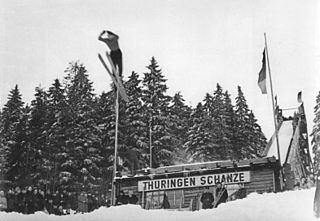
Thüringenschanze or Thuringia ski jump, known as Hindenburg ski jump until 1945, was a ski jumping hill in Oberhof in the Thuringian Forest. The large hill, which was built between 1925 and 1927, was one of the largest ski jumps in Germany for over 50 years in terms of jump distances. It was located on the western slope of the Wadeberg next to the youth ski jump on the outskirts of Oberhof. It hosted the ski jumping competitions of the Nordic World Ski Championships in 1931 and numerous other ski jumping competitions with international participants. The construction point (K-point), the size for which a ski jump is designed, was last at 82 meters after several conversions and extensions and the hill record, set by Jens Weißflog in 1981, was 83.5 meters. It was demolished in 1986.




















